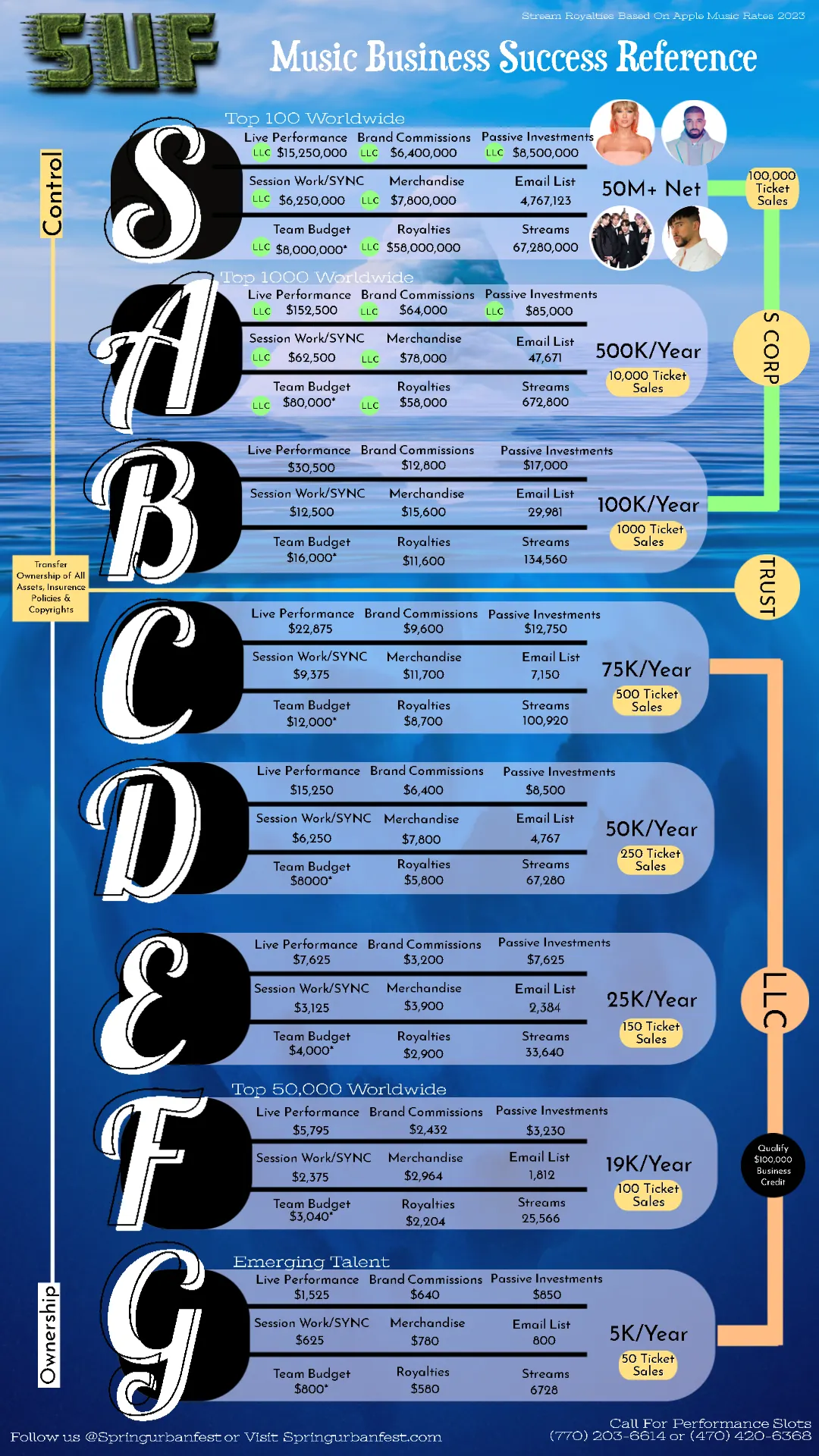Exploring the Path to Financial Success in the Music Industry

In the highly competitive music industry, artists strive for financial success while pursuing their passion. However, understanding the various avenues through which musicians can generate income is crucial for their long-term progression. In this article, we will delve into a classification system that assesses an artist's business growth and level based on their annual and cumulative accomplishments in generating revenue on a global scale. This system categorizes artists into different levels, ranging from G (the lowest) to S (the highest), and takes into account multiple streams of income, such as ticket sales, live performances, brand commissions, passive investments, session work/sync, merchandise sales, email list engagement, team budget allocation, royalties, and streaming figures. Let's explore the different levels and the opportunities they present.
- Ticket Sales: Ticket sales are a crucial revenue stream for artists. Selling tickets to concerts, tours, and live performances allows artists to monetize their talent and connect with their fans directly. Increasing ticket sales indicates growing popularity and can lead to higher earnings and opportunities for larger venues.
- Live Performance: Live performances encompass concerts, festivals, and other stage appearances. Artists generate income through performance fees and merchandise sales during these events. A successful live performance can attract more fans, increase demand for future shows, and boost an artist's reputation and earning potential.
- Brand Commissions: Brand commissions involve collaborations and partnerships with companies and brands. Artists endorse products or services, feature in advertisements, or create branded content. These collaborations not only provide financial compensation but also help increase an artist's exposure and reach new audiences.
- Passive Investments: Refer to income generated from investments in stocks, real estate, or other assets. Artists can use their earnings to invest strategically, generating additional income over time. This diversification of income sources helps secure an artist's financial future and provides stability outside of their primary music-related revenue streams.
- Session Work/Sync: Session work involves providing musical contributions, such as recording vocals or playing instruments, for other artists' projects. Artists receive compensation for their services, contributing to their overall income. Sync placements involve licensing an artist's music for use in advertisements, films, TV shows, or video games. These opportunities provide exposure, royalties, and additional revenue streams.
- Merchandise: sales include items like t-shirts, posters, albums, and other branded products. Artists often sell merchandise at live performances, through online stores, or partnerships with retailers. The profit margin on merchandise can be significant, making it a valuable income source, especially for artists with dedicated fan bases.
- Email List: Building an email list allows artists to directly communicate with fans, promoting new releases, tours, and merchandise. It provides a reliable channel for engagement, increasing the chances of ticket sales, merchandise purchases, and streaming activity. A robust email list is a valuable asset for artists to nurture their fan base and generate consistent revenue.
- Team Budget:The team budget refers to the allocation of funds for essential team members, such as managers, agents, publicists, and lawyers. Investing in a competent and supportive team is crucial for an artist's career growth and success. These professionals help manage contracts, negotiate deals, secure opportunities, and handle various aspects of the artist's business affairs.
- Royalties: Earnings generated from copyrighted works. Artists receive royalties from various sources, including music streaming platforms, radio play, public performances, and synchronization licenses. Royalties are an important income stream that continues to generate revenue over time, even when an artist is not actively releasing new music.
- Streams: Streaming figures represent the number of plays an artist's music receives on digital platforms. Streaming revenue comes from platforms like Spotify, Apple Music, and YouTube. As streaming becomes the primary mode of music consumption, higher streaming numbers indicate popularity, wider reach, and increased revenue potential for artists.
By understanding and optimizing these different revenue streams, artists can develop a sustainable and diversified financial strategy, ensuring long-term success in the ever-evolving music industry.
Business Classification of Artist

G: Emerging Artist
As an emerging artist, your primary focus is on building a foundation for your music career. At this stage, your revenue may be around $5,000, derived from various sources such as ticket sales, live performances, brand commissions, passive investments, session work/sync, merchandise sales, royalties, and streaming. While your numbers may be modest, it's crucial to establish a loyal fan base, grow your email list, and collaborate with brands to expand your reach.
- Revenue $5000
- Ticket sales: 50
- Live Performance: $1,525
- Brand Commissions: $640
- Passive Investments: $850
- Session Work/SYNC: $625
- Merchandise: $780
- Email List: 477
- Team Budget: 800
- Royalties: $580
- Streams: 6798
F: Top 50,000 Worldwide
Once you reach this level and have established business credit, your revenue increases to approximately $19,000, indicating a solid presence in the music industry. At this stage, your ticket sales, live performances, brand commissions, passive investments, session work/sync, merchandise sales, royalties, and streaming figures all contribute to your overall earnings. It's essential to focus on strengthening your team, building a substantial email list, and maximizing your revenue streams. Explore additional opportunities for session work and sync placements to further enhance your financial success and reputation within the industry.
- Revenue $19,000
- Ticket sales: 100
- Live Performance: $5,795
- Brand Commissions: $2,432
- Passive Investments: $3,230
- Session Work/SYNC: $2,375
- Merchandise: $2,964
- Email List: 1,812
- Team Budget: $3,040*
- Royalties: $2,204
- Streams: 25566
E: Reaching the $25,000 Milestone
Achieving $25,000 in revenue is a significant milestone for any artist. By this point, you should be generating income from ticket sales, live performances, brand commissions, passive investments, session work/sync, merchandise sales, royalties, and streaming. As your email list grows and your team expands, consider allocating resources to enhance your live performances and explore strategic partnerships that align with your brand and audience.
- Revenue $25,000
- Ticket sales: 150
- Live Performance: $7,625
- Brand Commissions: $3,200
- Passive Investments: $7,625
- Session Work/SYNC: $3,125
- Merchandise: $3,900
- Email List: 2,384
- Team Budget: $4,000*
- Royalties:$2,900
- Streams: 33640
D: Stepping Up to $50,000 Revenue
As you cross the $50,000 revenue mark, your career gains momentum. Your ticket sales, live performances, brand commissions, passive investments, session work/sync, merchandise sales, royalties, and streaming contribute to your success. At this level, focus on building a substantial email list, managing your team effectively, and exploring opportunities for passive investments to secure your financial future.
- Revenue $50,000
- Ticket sales: 250
- Live Performance: $15,250
- Brand Commissions: $6,400
- Passive Investments: $8,500
- Session Work/SYNC: $6,250
- Merchandise: $7,800
- Email List: 4,767
- Team Budget: $8000*
- Royalties: $5,800
- Streams: 67,280
C: Reaping Rewards at $75,000 Revenue
With $75,000 in revenue, you're well on your way to financial stability. Your ticket sales, live performances, brand commissions, passive investments, session work/sync, merchandise sales, royalties, and streaming figures all play a role in your continued growth. Capitalize on your email list by engaging with your fans consistently, expand your team strategically, and consider establishing a trust to safeguard your assets and explore further monetization avenues.
- Revenue $75,000
- Ticket sales: 500
- Live Performance: $22,875
- Brand Commissions: $9,600
- Passive Investments: $12,750
- Session Work/SYNC: $9,375
- Merchandise: $11,700
- Email List: 7,150
- Team Budget: $12,000*
- Royalties: $8,700
- Streams: 100,920
B: Striving for $100,000 Revenue
Reaching $100,000 in revenue is a significant milestone that showcases your dedication and talent. At this level, your ticket sales, live performances, brand commissions, passive investments, session work/sync, merchandise sales, royalties, and streaming numbers all contribute to your overall earnings. Focus on growing your email list, investing in your team's development, and exploring innovative ways to diversify your income streams.
- Revenue $100,000
- Ticket sales: 1000
- Live Performance: $30,500
- Brand Commissions: $12,800
- Passive Investments: $17,000
- Session Work/SYNc: $12,500
- Merchandise: $15,600
- Email List: 29,981
- Team Budget: $16,000*
- Royalties :$11,600
- Streams: 134,560
A: Among the Top 1,000 Worldwide
As one of the top 1,000 artists globally, your revenue reaches $500,000. Your ticket sales, live performances, brand commissions, passive investments, session work/sync, merchandise sales, royalties, and streaming figures all contribute significantly to your financial success. At this level, maximize your email list engagement, invest in your team's capabilities, and explore opportunities for massive growth, such as sync placements and merchandise collaborations.
- Revenue $500,000
- Ticket sales: 10,000
- Live Performance: $152,500
- Brand Commissions: $64,000
- Passive Investments: $85,000
- Session Work/SYNC: $6,250,000
- Merchandise: $7,800,000
- Email List: 47,671
- Team Budget: $80,000*
- Royalties: $58,000
- Streams: 672,800
S: Among the Top 100 Worldwide
Congratulations! You've reached the pinnacle of success, with revenue surpassing $5,000,000. Your ticket sales, live performances, brand commissions, passive investments, session work/sync, merchandise sales, royalties, and streaming figures are all at their peak. As an artist in the top 100, it's crucial to leverage your massive email list, allocate resources wisely within your team, and ensure proper management of your revenue streams and assets.
- Revenue $50,000,000+
- Ticket sales: 100,000
- Live Performance: $15,250,000
- Brand Commissions: $6,400,000
- Passive Investments: $8,500,000
- Session Work/SYNc: $6,250,000
- Merchandise: $7,800,000
- Email List: 4,767,123
- Team Budget: $8,000,000*
- Royalties:$58,000,000
- Streams: 67,280,000
Conclusion:
Up to this point, as an artist, you may have built an impressive catalog of music. To ensure long-term wealth generation and effective risk management, it is essential to adopt forward-thinking measures. Consider creating a trust and transferring all your real and intellectual assets to it. This proactive step gives you greater control over your assets and opens up avenues for monetization in various ways.
To optimize your financial strategies, it is also worth exploring the formation of an S Corporation. This type of corporate structure can help manage tax utilization and liability, particularly for artists with revenue streams exceeding $50,000. By taking advantage of the benefits provided by an S Corporation, you can optimize your financial position and protect your assets more efficiently.
Understanding the different levels of financial success in the music industry is crucial for your career advancement. By focusing on building business credit and diversifying your revenue streams through ticket sales, live performances, brand commissions, passive investments, session work/sync, merchandise sales, royalties, and streaming, you can progress from being an emerging artist to becoming a global sensation.
Adapting your strategies at each level is key to sustaining growth. This includes nurturing your email list to foster stronger connections with your fans, assembling a reliable and competent team, exploring new income streams, and safeguarding your assets for long-term wealth generation.
To fully realize your potential as a successful musician, remember to embrace perseverance, creativity, and strategic decision-making. By combining these qualities with a comprehensive understanding of the industry and a proactive approach to financial management, you can pave the way for continued success and achieve your goals in the ever-evolving music industry.
By: Lem Luvah
Remarks…
Be sure to Sign up to the Newsletter to keep up with the latest from me. If anything in this article resonated with you, Leave A Comment or Reaction. If you think It would benefit someone you know, Share even if you have an opposing opinion. We all grow by evolving through conversation and want to build a community where it feels safe to do that. Be sure to join the Facebook Group.
Let's Have A Conversation Of Our Own About Your Music Journey
__________________________________________________________________________________
Check Out My Other Articles in the Artist Business Class Series
__________________________________________________________________________________
Download My Free No Bull$#!% Budgeting Template for Artist Get your Best Foot Forward With Your Lifestyle Goals
| Download |
__________________________________________________________________________________
Download Free Music Business Ebook
















